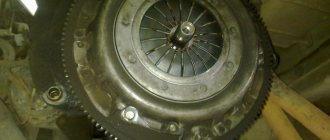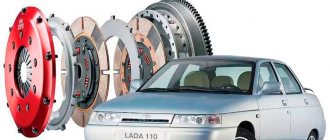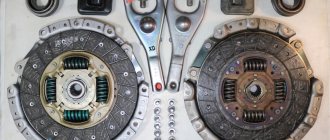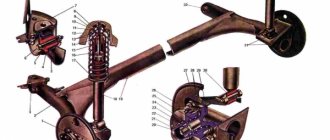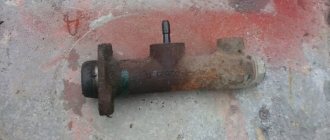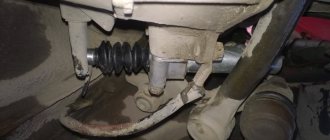Clutch disc assembly
The clutch is one of the components of a car's transmission. When this system breaks down, further movement becomes difficult, sometimes the car stalls, and sometimes it simply does not move when you press the accelerator pedal. Let's look at how to diagnose and replace clutch elements of a VAZ 21099 car with your own hands.
Clutch system failures are felt instantly, here is a list of the main symptoms.
- When driving uphill, when you press the gas pedal, the car does not move, despite the ever-increasing engine speed.
- When driving in a straight line, acceleration time increases significantly, the engine often overheats, and fuel consumption increases.
- When stopping, pressing the brake and clutch pedals simultaneously will stall the engine.
- It is difficult and crunching to switch gears on and off when the car is moving. When the engine is off, they switch without difficulty.
- In the morning, when you try to start the car, the starter has difficulty turning the flywheel, despite the clutch pedal being depressed, and after starting, the engine runs hard and stalls after a while.
- There is a noise when you press the pedal.
- When changing gears, the car makes a jerk, and sometimes the engine stalls after it.
- The clutch release pedal is difficult to press.
- Full pedal travel exceeds 16 cm.
Causes and troubleshooting
Installing the disk on the machine
Symptoms 1 and 2 indicate critical wear of the clutch driven disc or contamination of it with engine oil that has leaked from the cylinder block or gearbox due to leaky seals of these units. To more accurately determine the cause, just look into the engine compartment and look through the window on the clutch housing cover. If there are traces of oil on the flywheel teeth, then the seals will have to be replaced. If there are no traces of oil, the clutch driven disc needs to be replaced.
Symptoms 3, 4 and 5 indicate incomplete shutdown of the mechanism. This occurs when drive parts break, driven and pressure disks are deformed, the cable breaks and the VAZ clutch drive is incorrectly adjusted.
Symptom 6 indicates a breakdown of the damper springs or wear of the release bearing. Symptom 7 indicates that the wheel hubs are jammed on the gearbox shaft splines. They just need to be removed, cleaned and lubricated. Symptoms 8 and 9 indicate that the cable needs to be replaced and the drive adjusted. Replacing the clutch assembly is also carried out after purchasing a used car.
Adjusting the VAZ 21099 clutch drive is a very simple procedure, it is done like this.
- First you need to take a ruler and measure the distance the pedal moves when pressed. If it is less than 12.5 or more than 13.5 cm, we proceed to adjustment.
- We look into the engine compartment, remove the battery, find the place where the cable passes through the gearbox bracket (next to the ignition coil). It is secured with adjusting nuts on both sides of the bracket.
- If we need to increase the pedal travel, turn the nut located clockwise, located closer to the car interior. If, on the contrary, it is necessary to reduce the stroke, turn clockwise the nut that is closer to the front bumper.
- Again, measure the distance with a ruler: if it is within the recommended limits, the adjustment is complete.
Replacing the cable is also not a very difficult task.
- Open the hood and unscrew the adjusting nuts.
- Remove the cable from the gearbox bracket.
- Remove it from the clutch fork.
- We move into the interior, knock the lock washer off the pedal pin and remove the cable end.
- We take out the rubber gasket from the front panel from the side of the engine compartment and take the tip out.
The cable has been removed, now we install the new one in the reverse order. After installation, adjustment is required again.
https://youtu.be/https://youtu.be/1858lZXHZ-g
_
Complex procedures
Replacing the clutch on a VAZ 2108-21099 is a labor-intensive and time-consuming process. To do this, you first need to remove the gearbox. After the gearbox is removed, you can proceed to the following operations.
Replacing the clutch cable
Replacing the fork and release bearing.
- Using a screwdriver, remove the protective cover of the plug.
- Unscrew the bolts securing the clutch basket and remove it.
- Use a screwdriver to press the spring off the release bearing clutch legs.
- We remove the bearing.
- We remove the spring.
- Unscrew the 3 bolts and remove the bearing guide sleeve.
- Use a screwdriver to grab the special protrusion and remove the plastic bushing of the fork.
- We remove the fork axle from the support sleeve and remove it from the basket.
Disassembly is complete, now we install new parts in the reverse order. When installing, it is necessary to lubricate the fork bushings with CV joint-4 grease.
- First, remove the basket and lock the flywheel.
- Unscrew the 6 bolts securing the casing to the flywheel.
- Carefully remove the clutch cover along with the driven disc, holding it with your hand.
- We inspect all parts for cracks and wear. We replace defective parts.
- We put everything back together in reverse order.
Clutch repair on VAZ 2108, VAZ 2109, VAZ 21099 cars
1. Remove the gearbox from the VAZ 2108, VAZ 2109, VAZ 21099 (see “Removing and installing the gearbox”).
1:709 2. Install the mandrel into the pressure plate hole.
NOTE You can remove the clutch without a mandrel, but at the same time hold the clutch driven disc - the driven disc may fall out of the clutch housing.
USEFUL ADVICE A mandrel for centering the driven disk can be made according to the dimensions of the input shaft, or you can use the old gearbox input shaft instead of the mandrel.
2:1911 3. Unscrew the six bolts securing the clutch housing
leniya. Remove the clutch housing assembly with the pressure plate and driven disc installed inside the clutch housing. Hold the clutch driven disc while doing this, otherwise the driven disc may fall out.
NOTE When removing the clutch housing bolts, block the flywheel using a screwdriver.
3:1061 To stop the screwdriver, install one bolt securing the clutch housing (for clarity, the operation is shown with the engine removed).
4:1801 4. Cracks on the driven disk parts are not allowed. Check the wear of the friction linings 1. If the heads are behind
moldings 2 are deepened to a distance of less than 0.2 mm, the surface of the friction linings is oily or the rivet joints are loose, then the clutch driven disc must be replaced. Check the reliability of the damper springs 3 in the sockets of the driven disc hub; if the damper springs are broken, the clutch driven disc must be replaced.
5:1130 5. Check the runout of the driven disk if warping of the driven disk is detected during visual inspection. If the driven disc runout exceeds 0.5 mm, replace the clutch driven disc.
6:1965 6. Inspect the working
e friction surfaces of the flywheel and clutch pressure plate, paying attention to the absence of deep marks, scuffs, nicks, obvious signs of wear and overheating. Replace defective components.
7:839 7. If the rivet connections 1 of the housing parts and the clutch pressure plate are loosened, replace the housing with the pressure plate assembly. Using an external inspection, evaluate the condition of the diaphragm spring 2 of the clutch pressure plate. Cracks on the diaphragm spring are not allowed. The contact points between the spring petals and the clutch release bearing must be in the same plane and have no obvious signs of wear (the amount of wear should not exceed 0.8 mm). Otherwise, replace the clutch pressure plate assembly.
8:2321
8. Using an external inspection, evaluate the condition of the support rings of the pressure spring. The pressure spring rings should not have cracks or signs of wear. Otherwise, replace the housing and pressure plate assembly.
9:861
Fig.
5.4. Checking the condition of the clutch drive disk: A, B, C - controlled dimensions; 1 - pressure spring; 2 - casing; 3 — pressure disk; 4 - intermediate ring
9. To check the clutch drive part, secure the pressure disk 3 (Fig. 5.4) assembled with the pressure spring 1 and casing 2 to a device with an intermediate ring 4 with a thickness of B = (8.3 ± 0.04) mm. This device replaces the flywheel with the clutch driven disc. Disengage the clutch three times with a release stroke of 8-9 mm, applying a load to the petals of pressure spring 1 at a diameter of C = 34 mm. In this case, check that: - the shutdown stroke (8.0+0.1) mm corresponds to the pressure plate stroke of at least 1.4 mm; — the difference in the deviation values of pressure plate 3 was no more than 0.25 mm; — size A was in the range of 29-31 mm; — the load on the petals of pressure spring 1 at diameter C with a stroke of (8.0+0.1) mm was no more than 1100 N, the peak shutdown load was no more than 1300 N. 10. Before installing the clutch on a VAZ 2108, VAZ 2109, VAZ 21099 check the ease of movement of the driven disk along the splines of the gearbox input shaft. If necessary, eliminate the causes of jamming or replace defective parts.
10:3378
11. Please note that when installing the clutch driven disc into the clutch pressure plate housing, the more protruding part of the hub is directed towards the pressure spring.
11:834 12. Insert the centering mandrel into the splines of the driven disk from the pressure spring side.
12:1498 13. Install the clutch on the flywheel along the three centering pins (shown by arrows) and tighten the six bolts securing the clutch to the flywheel evenly diagonally, holding the flywheel from turning. After this, remove the centering mandrel and install the box in front
h.
next article:
replacing the clutch release bearing on VAZ 2108, VAZ 2109, VAZ 21099 cars
1. Remove the gearbox from the VAZ 2108, VAZ 2109, VAZ 21099 (see “Removing and installing the gearbox”).
2.
13:934
Rating 5.00 [1 Vote]
21963
Symptoms of malfunction
The clutch release bearing itself will tell you that its life is already at its limit or it has completely failed. Therefore, your task is to monitor the behavior of the car and promptly respond to emerging problems.
Sign of breakdown
Peculiarities
The clutch pedal becomes hard to press
Initially, this only causes a certain discomfort, since you have to apply more force to change gears. But this phenomenon should not be ignored. Bearing needs to be replaced
Difficulty engaging first and reverse gears
This indicates that the bearing's life is gradually ending, and you urgently need to take action. If you don't do this, you will soon be unable to engage any of the gears in your transmission.
The car doesn't pull
There is a loss of efficiency and performance of the box. Consequently, it is not possible to change gears correctly and quickly. This makes maneuvers, overtaking and a banal increase in speed more difficult.
This happens occasionally at first, and therefore almost every time you change gears. This symptom clearly indicates that it is time to send the car to a service station or garage for repairs.
Old and new VP
If the release bearing is not replaced in a timely manner, the gearbox will soon fail, the clutch will not work, and this will lead to dire consequences.
Consequences of wear
If you have encountered such a phenomenon as wear of the clutch release bearing, then you probably often drive your own VAZ 2109. It is time and the many kilometers traveled that lead to such breakdowns.
If the bearing is not replaced in time, this will result in the following consequences:
- Any subsequent trip may be the last for the car;
- The clutch disc will overheat, which will lead to destruction of the lining;
- In addition to replacing the bearing, you will have to replace the entire clutch disc;
- It is not uncommon for the clutch to fail. If you hear an incomprehensible noise coming from the clutch system, then there is a problem with it.
Replacement
Not all car owners decide to replace the release bearing (TR) themselves. But if you are ready for this kind of work, then go for it.
VI components
Therefore, think twice before making a final decision. There is always the opportunity to contact a car service.
To work you will need the following set of tools and materials:
- Set of wrenches;
- Jack;
- Several durable bricks;
- New release bearing;
- Screwdriver Set;
- Container for draining transmission fluid;
- Clutch holder;
- Garage with a pit or lifting mechanism.
It is better to divide the entire replacement procedure into two main stages.
- Removing the gearbox.
- Bearing replacement.
Many people make the mistake of relaxing too much when they finally change the bearing. In practice, reassembly often causes more problems than dismantling work. Please take this into account.
Dismantling the gearbox
- Place the car over a hole or overpass.
- Lift the hood, remove the negative terminal from the battery and throw it aside.
- Disconnect the ground wire from the clutch housing.
- Use a screwdriver to remove the engine splash guard. To do this, you need to unscrew several screws that hold the mudguard to the elements of the side wings. For the VAZ 2109, a key size of 8 is used. Having removed all the screws there, remove the parts of the engine mudguard and put them away for now.
- Disconnect the transmission drive rod. To do this, use a 13mm wrench to loosen the clamp bolts. Next, use a screwdriver to separate the ends of the clamp and disconnect the element from the gearbox.
- Be sure to disable the reverse optics sensor.
- Place blocks or bricks under the rear wheels of the car to prevent the car from moving.
- Remove the front wheels by first loosening the bolts and lifting the front part of the body. After removing the wheels, place pre-prepared bricks under the body.
- Using a 17 wrench, unscrew the nuts securing the ball joint to the steering knuckle on both sides.
- The extension is moved to the side, and the fastening screws of the left extension to the vehicle's suspension arm are unscrewed.
- Using a 10 mm wrench, remove the fasteners of the lower clutch housing cover.
- Remove the transmission mounts. This is done as follows. Place supports or bricks under the engine and a jack under the box. Unscrew the mounting screws of the support to the body with a 17mm wrench. After removing the bolt, remove the support bracket by unscrewing several corresponding nuts.
- We proceed directly to dismantling the gearbox. Using a 19 wrench, unscrew the fasteners of the clutch housing to the cylinder block. Use a jack to lower the gearbox slightly and move it away from the engine. Lower until the input shaft begins to come out of the box.
- Enlist the support of a partner, since it is quite difficult to remove the gearbox alone.
- Make sure that the gearbox input shaft does not rest on the clutch spring petals. If you allow this situation to happen, you will simply damage them.
- Carefully place the gearbox on the supports, being careful not to hit it. Otherwise, repairs will cost much more than buying a new bearing.
Removing the gearbox without clutch.
If we systematize the necessary actions for removing the gearbox from a VAZ 2109, then all the stages will look something like this:
- Remove the starter: to do this, after all wires and terminals have been disconnected, you need to unscrew 3 nuts;
- We disconnect the gear shift drive, having first loosened the clamp;
- Disconnect the speedometer cable and reverse cable;
- Unscrew the fasteners of the braces to the suspension arms and move them apart;
- Disconnect the ball joints from the swing arms: to do this, first pull out the cotter pin and unscrew the nut, then knock out the support pin and unscrew the two nuts to disconnect the hinge;
- Using a pry bar, press out the tip of the inner CV joint (do not forget to plug the resulting holes in the box, as you can spill oil from the gearbox);
- The lower clutch housing protection is removed: to do this, just unscrew 3 bolts;
- The engine and gearbox are supported from some kind of bars;
- The rear supports are unscrewed;
- Having unscrewed the remaining bolts, the gearbox is pulled off horizontally, trying not to damage the pressure spring petals with the input shaft.
Clutch cable
Signs and causes of clutch failure
The VAZ 2108, 2109, 21099 clutch consists of a basket, a pressure bearing, a drive and driven disk. The main signs of a clutch malfunction are clutch slipping and incomplete disengagement:
- When switching off is incomplete (the pedal is pressed), there is difficulty shifting gears with the engine running, noise and crackling noises when changing gears, and large free play of the clutch pedal.
- When the clutch “slips” (the pedal is released), a burning smell may be felt in the cabin from the burning of the clutch disc linings, the car’s dynamics will deteriorate, the engine may overheat, and fuel consumption will increase.
In addition to the clutch disc itself, the release bearing can also fail - it serves to smoothly engage and disengage the clutch. When the release bearing wears out to the limit, you can hear a characteristic squealing sound - this is a sure sign that the bearing needs to be replaced. The cause of clutch failure may also be a breakdown in its drive mechanism, for example, a break or jamming of the clutch drive cable, a breakdown of the lever system, a fluid leak from the hydraulic drive if the clutch is hydraulic, or other similar breakdowns in the drive.
By the way, when replacing the release bearing at a service station, they may advise you to also replace the clutch disc. Usually, if problems begin with the clutch, it is better to replace all these parts, because replacing the clutch is very difficult: you need to remove the gearbox. But if someone wants to save on this, then all clutch parts can be purchased separately.
To work you will need the following:
- wrenches 8, 10, 13, 17 mm;
- torque wrench, 8 mm socket;
- jack;
- container for draining oil;
- inspection hole or lift.
- flat screwdriver, hammer.
We repair it ourselves (VAZ classic)
We replace the DS and KS on a rear-wheel drive VAZ as follows:
- place the car on a car lift or pit;
- turn off the engine, put the car in neutral gear;
- remove the gearbox lever mounting cover (unscrew the screws);
- we dismantle only the upper part of the gearbox lever; there is no need to remove it completely (we disconnect it at the place marked by the arrow in the figure);
- unscrew the propeller shaft bolts, dismantle the shaft itself (make marks on the cardan and rear axle gearbox - this is necessary in order to secure the shaft according to the same marks during installation to avoid unnecessary vibrations);
- disconnect the speedometer cable from the gearbox, as well as the control center;
- unscrew all the gearbox fasteners (including the traverse), remove the gearbox;
- unscrew the six bolts securing the basket, remove the parts;
- We put new parts in place and put everything back together.
When installing new spare parts, the disk must be centered, otherwise the manual transmission will not fit into place. A factory mandrel or an old “primary” from a “classic” gearbox is used as a center.
Replacing the clutch on a VAZ 2109/21099 without removing the gearbox
Replacing the VAZ 2109/21099 clutch without removing the gearbox is quite difficult. You will not find instructions or recommendations on this topic in the car's owner's manual. These recommendations are based on the experience of car enthusiasts who share their experience of replacing the clutch.
The main problem when replacing a clutch is that not every motorist has an overpass, a pit, and especially a lift, and it is necessary to make sure that the massive gearbox does not fall to the ground. But lifting it is problematic, since it is impossible to crawl under the car with it. All steps for removing the gearbox are almost the same as the instructions above, with the exception of some nuances:
- Purchase two bolts from the upper arm of the classic front suspension from the store. Their threads are exactly the same as those on the bolts that secure the box and the engine block together.
- Screw them in from above, only after that, with a small crowbar or screwdriver, we begin to disconnect the nodes. After moving away, the rear part of the box will rest on the transverse rod, and a gap of about 15 centimeters will form between the clutch housing and the flywheel.
- The release bearing is removed through the resulting gap and the bolts on the basket are unscrewed.




